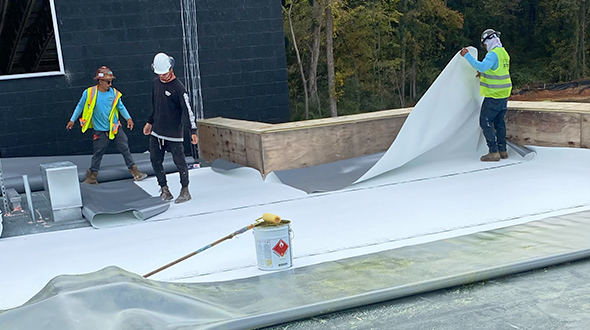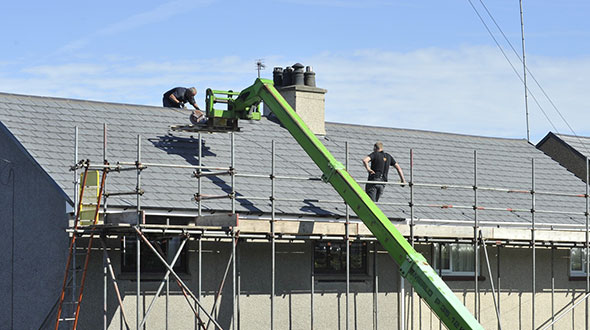
Prevent catastrophic damages and injuries from a failed roofing system. Knowing how long different roofing systems are supposed to last will help you get it evaluated and replaced when the time is right.
atlantacommercialroofingcontractors.com gathered the following information to help you determine when your damaged or aging roofing system needs to be replaced.
What Impacts How Long a Roof Lasts?
Each type of roofing system has a projected lifespan. What determines a roofing system’s longevity includes:
- Bi-annual inspections (spring and fall) under a maintenance program
- Early detection of hidden problems/defects in the roofing system
- Material quality
- Installation quality (workmanship)
- Weather patterns (severe weather events like hail, tornadoes, hurricanes, etc.)
A well-installed roofing system with continuous maintenance, care, and eventual repairs can last from 20 to 100 years, depending on the roofing material. Consider the following roofing systems:
Composition Shingles 15 – 40 Years
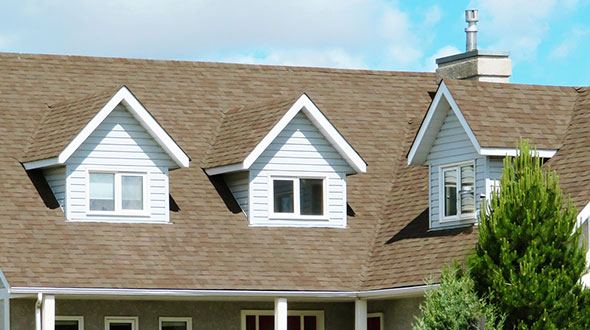
Composition shingles are a composite product made from a fiberglass or cellulose mat, asphalt, and mineral granules. Composition shingle roofing systems are also environmentally friendly. Most composite roof materials are made with a paper backing and produced using recycled materials.
This durable roofing system can last an average of 15 to 20 years with minimal maintenance and care. When properly installed and maintained, this roofing system can last up to 40 years.
Signs that a composition shingle roof replacement may be necessary include:
- Visible signs of roof or shingle aging
- Multiple leaks
- Missing mineral granules
- Shingle curling (most common along edges)
- Missing shingles
- Moss growth on shingles
- Algae growth (dark stains running down the roof slope)
Severe weather events are common factors in roofing system damages and failures. After such events, your roofing system should be inspected and repaired if possible.
Note 1: A typically hidden problem with shingle roofing systems is bad shingle adhesion. Contributing factors often include manufacturing inconsistencies, poor installation practices, advanced aging and shingle deterioration, cold weather installations, lack of attic ventilation, and repeated thermal expansion and contraction.
Note 2: Another, often hidden, issue occurs when gaps or openings are left in a roofing system's eaves, soffit, or fascia. These openings allow small animals/wildlife to enter attic space, destroying insulation or compromising a roofing system's integrity from the inside out.
Asphalt Shingles 10 – 20 Years

Asphalt shingles are not made solely of asphalt. They consist of either a fiberglass or felt paper base coated with a waterproof layer of asphalt and topped with mineral or ceramic granules. Over the past four decades, fiberglass-based shingles have been the more requested product.
This roofing system can last an average of 10 to 15 years with minimal maintenance and care. When properly installed and maintained, this roofing system can last up to 20 years.
Similar to composition shingles, signs that an asphalt shingle roof replacement may be necessary include:
- Visible signs of roof or shingle aging
- Multiple leaks
- Missing mineral granules
- Shingle curling (most common along edges)
- Missing shingles
- Moss growth on shingles
- Algae growth (dark stains running down the roof slope)
Note: Shingle roofing systems often hide water damage from failed flashing in valleys, around chimneys, and in poorly constructed chimney crickets or saddles. This type of failure can lead to multiple leaks, deck rotting, and eventual roof failure.
Severe weather events are common factors in roofing system damages and failures. Again, after such events, your shingle roofing system should be inspected and repaired if possible.
Wood Shingles Up to 30 Years
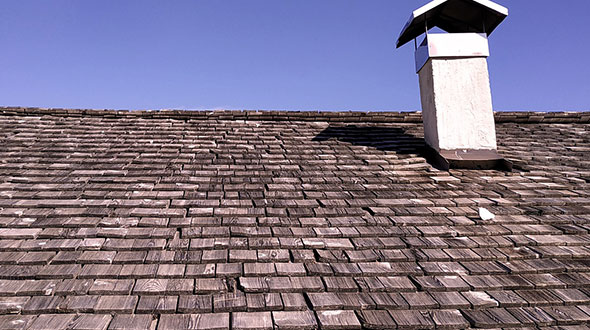
Wood shake roofing and a wood shingle system are both typically made from cedar, cypress, redwood, or pine. While these wood products have similarities, they're produced differently. Wood shingles are usually machine cut on both sides, and wood shake material is created by splitting rectangles from a log.
Being rot and insect resistant, a wood shingle roofing system can last up to 30 years with diligent annual upkeep.
Signs that wood shingle or wood shake roof replacement may be necessary include:
- Visible signs of aging or damage in multiple areas of the roof
- Multiple leaks
- Cracking, splitting, or warping shingles
- Missing shingles
Often, these signs will be confined to a section of the roof, which may mean only a repair is needed.
Note: A commonly hidden problem with wood shingle roofing systems is a poorly ventilated attic. Moisture that cannot escape the attic is forced upward through the roof structure causing shingles to curl and buckle. This uneven warping traps water, exacerbating the roof's deformation and rapid decay of its framework.
Single-ply Membrane (TPO & PVC 15-30 Years, EPDM 30-50 Years)
Single-ply membrane roofing systems require fewer seams than asphalt roofing systems and don't require torches or hot asphalt for installation. Single-ply systems come with prefabricated finishing accessories that make installation easy. Consider the following:
TPO – TPO (thermoplastic polyolefin) is a single-ply membrane and is one of the fastest-growing commercial and residential roofing systems. TPO roofing systems are made of a single layer of synthetics and a reinforcing scrim used to cover flat roof substrates.

Because TPO is relatively new in the roofing industry, its full lifespan has yet to be determined. This roofing system can last an average of 15 to 20 years with minimal maintenance and care. When properly installed and maintained, this roofing system can last up to 30 years before replacement.
To learn the benefits, cost, and problems related to a TPO roofing system, read the TPO Roofing System Explained article.
Signs that a TPO roof replacement may be necessary include:
- Visible signs of aging or damage in multiple areas of the roof
- Multiple leaks
- Chronic ponding
- Severe alligatoring (shrinkage and cracking)
Note 1: Often overlooked and elusive are damages caused by a parapet wall's failed metal coping. This roofing system malfunction allows water to collect between the TPO membrane and roof substrate, ultimately resulting in leaks, membrane deterioration, and structural damages to the building.
Note 2: Another hidden problem for flat or low-sloped roofing systems occurs when internal drainage (drainage routed through the structure) becomes clogged. A blocked drainage system can lead to ponding and severe water damage requiring costly structural repairs and roofing system replacement.
Detected early, these issues can be halted with repairs. When the roofing system becomes compromised in multiple locations, replacement may be the only option.
PVC – PVC (polyvinyl chloride) roofing is a single-ply roofing system used on commercial, industrial, and residential flat or low-sloped roofs. PVC is among the world’s most widely produced synthetic plastic polymer.
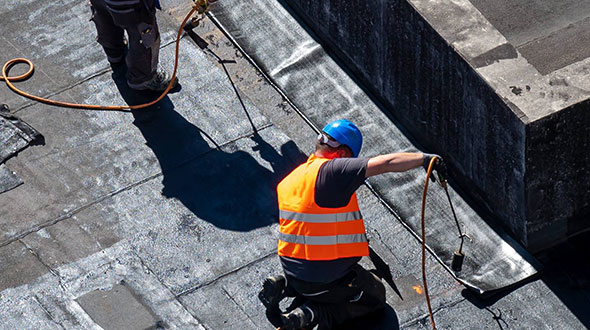
Like TPO, this roofing system can last an average of 15 to 20 years with minimal maintenance and attention. When properly installed and maintained, a PVC roofing system can last up to 30 years before replacement.
Like TPO, signs that a PVC roof replacement may be necessary include:
- Visible signs of aging or damage in multiple areas of the roof
- Long tears or rips
- Multiple leaks
- Chronic ponding
- Severe alligatoring (shrinkage and cracking)
Note 1: Improperly welded or damaged seams can allow water infiltration, often remaining undetected until extensive damages have occurred to the roofing membrane and substrate, requiring the roofing system's replacement.
Note 2: Foot traffic to and from electrical equipment and other rooftop installations can result in membrane tears and roofing system damage that can also go undetected until such damages require extensive repairs or roofing system replacement. This type of damage can be prevented by installing reinforced walkways or paths wherever foot traffic may be required.
Detected early, these issues can be halted with repairs.
PVC is somewhat similar when compared to TPO, but there are some unique advantages and we suggest knowing The Difference Between PVC and TPO Roofing Systems.
EPDM – EPDM (ethylene propylene diene polymethylene) is a durable synthetic rubber roofing membrane produced using two primary ingredients, ethylene and propylene, derived from oil and natural gas.

Utilized worldwide in the roofing industry, EPDM membranes exhibit a high level of stability as they age. This roofing system can last an average of 30 years with minimal maintenance and care. However, when properly installed and maintained, an EPDM roofing system can last up to 50 years before requiring replacement.
Signs that an EPDM roof replacement may be necessary include:
- Visible signs of aging or damage in multiple areas of the roof
- Long tears or rips
- Multiple leaks
- Chronic ponding
- Severe alligatoring (shrinkage and cracking)
- Use of improper repair materials, including asphalt and roofing cements
Note: One of the more elusive complications for this and all other flat roofing systems is an incorrect slope (these roofing systems are often referred to as low-slope roofing systems). If the slope is too low, ponding can occur with heavy precipitation or even the slightest drainage obstruction. Ponding or water pooling leads to rapid deterioration of all roofing system components and will likely result in the need for a complete roofing system replacement.
To learn more of the benefits, installation process, cost, warranty, and problems with an EPDM roofing system, read EPDM Roofing System Explained.
Built-up Roofing (BUR) 30+ Years
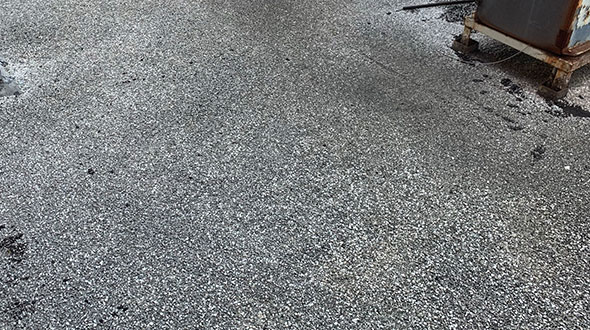
Built-up roofing systems consist of multiple layers of asphalt alternated with felt sheets applied over the roof deck (substrate), vapor retarder, and insulation that is attached to the roof decking. The system is then covered with a reflective membrane (cap sheet) or coating system.
Depending on the climate and materials used, a built-up roofing system has an average lifespan of 20 years. Well-installed and maintained BUR systems have been known to last 30+ years.
Signs that a BUR roof replacement may be necessary include:
- Multiple leaks (especially after having been repaired)
- Chronic ponding
- Severe weather or impact damage
Note: Leaks occurring in a built-up roofing system are often elusive, remaining hidden until severe damage has occurred to the roofing system and building structure. When a layered roofing system such as this develops multiple leaks, the likely course of action is to replace the system entirely.
To learn more of the installation process, benefits, cost, warranty, and potential problems with a Built-up roofing system, read the Built-up Roofing System (BUR) Explained article.
Modified Bitumen (ModBit) 15 – 25 Years
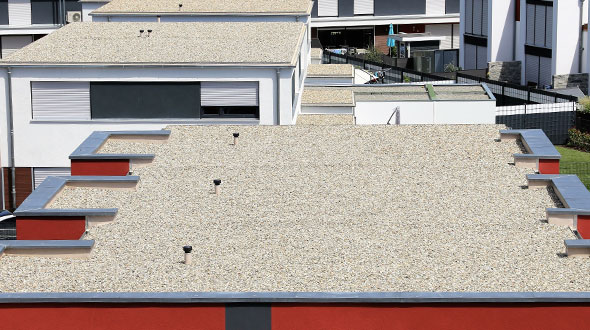
Modified Bitumen (ModBit) roofing is an asphalt-based roofing system similar to Built-up-Roof (BUR) and is designed for structures with low-slope or flat roof structures. Its five layers of protection make this roofing system one of the most trusted in the industry today.
Location, maintenance, and roof design are influencing factors on this system’s longevity. This roofing system can last an average of 15 years with minimal maintenance and care. When properly installed and maintained, a ModBit system can last up to 25 years before needing replacement.
Very similar to BUR, signs that a ModBit roof replacement may be necessary include:
- Multiple leaks
- Chronic ponding
- Severe weather or impact damage
Note 1:When this or other flat roofing systems are ballasted with gravel or stone, repairs will often require the removal of that gravel or stone. This process may ultimately require the partial or complete replacement of the roofing system.
Note 2: A common and barely noticeable problem with ModBit roofing systems involves vibrations from mechanical equipment causing mechanical fasteners to loosen and back out, leaving holes in the membrane. As this condition progresses, severe water damage including rusted components, substrate or decking deterioration, leaks, and costly structural damages occur and can remain virtually unnoticed until a partial or total failure of the roofing system.
Note 3: Roof coatings are commonly applied to aging roofing systems to extend their lifespan. In doing so, a roof coating may fail, allowing slow leaks to develop and remain undetected until severe structural damages occur. These damages become evident as interior leaks, sagging areas in the roof, severe ponding, and roofing system failure if left to develop.
To learn more about the modified bitumen product, benefits, warranty, cost, and potential problems with this roofing system, see this Modified Bitumen Roofing System Explained article.
Metal Roofing Up to 70 Years

Metal or tin roofing is a popular roofing system around the United States and in Canada. The term “tin” is used interchangeably with metal, steel, or galvanized steel roofing. However, tin is an incredibly rare element and unused for roofing.
This incredibly durable roofing system can last an average of 25 to 40 years with minimal maintenance and care. When properly installed and maintained, a metal roofing system can last up to 70 years before requiring replacement.
Signs that a metal roof replacement may be necessary include:
- Multiple leaks
- Rusting components
- Multiple damaged panels
- extensive weather or impact damage
Note: Due to the expansion and contraction of metal roofing, fastening and anchoring systems can weaken and fail over time. This problem can result in complete roofing system failure and is often only detected during routine maintenance visits.
To learn whether this type of roof suits your needs, read Metal Roofing Advantages and Disadvantages.
Clay Tiles 50 – 75 Years
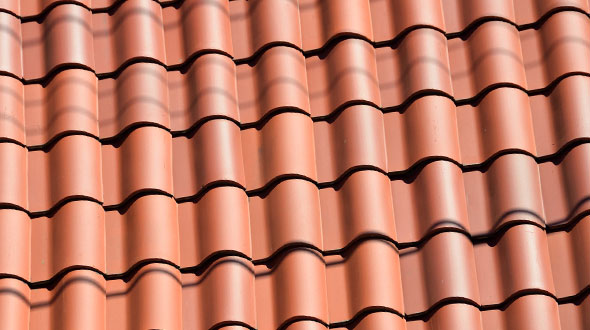
In use since the 17th century, clay tiles are made by baking molded clay. Tile density is determined by heating time and at what temperature. Known for their ability to withstand high winds, hail, and fire, these tiles are produced in white, yellow, orange, and brown shades.
A clay tile roofing system can last an average of 50 years. With proper installation and maintenance, a clay tile roofing system can reach 75 years before replacement is needed. In rare cases clay tile roofing can even reach a whopping 100 years.
Signs that a clay tile roof replacement may be necessary include:
- Multiple cracked, damaged, or missing tiles
- Roofing system sagging
- Severe weather or impact damage
Note: While clay tile roofing systems can be long-lived, flashing failures (corrosion or cracking), and fastener failures (rusting) often result in water damage to the roof's decking and multiple leaks in the structure below. This type of damage can remain dangerously elusive, only appearing during a maintenance inspection or when the roofing system partially or completely fails.
When damages are minimal or confined to a small area, clay tile roofing systems can be easily repaired. More extensive damages will likely require partial or full replacement.
Roofing Maintenance Program
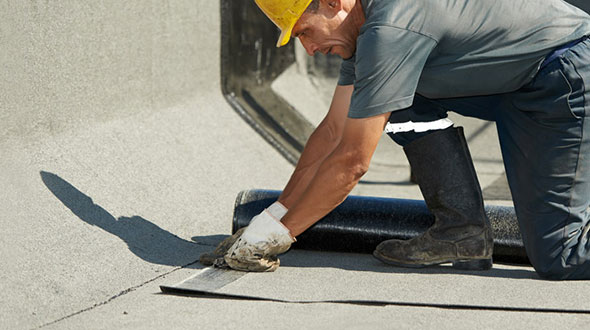
Roof maintenance plans are provided by commercial and residential roofing contractors, in which they agree to perform scheduled inspections, cleaning, debris removal, and scheduled or recommended preventative roof maintenance.
Acquiring a roofing maintenance program from a licensed roofing contractor allows property owners to protect the roof’s warranty provisions, extend the roof’s lifespan, and ultimately save money by preventing significant damages and costly repairs.
Most roof warranties require a minimum of one roof inspection per year performed by an authorized contractor. These inspections allow early detection of problems and their timely repair before developing into catastrophic problems, leading to a roof’s replacement.
Commercial Roofing Maintenance Programs and Services can greatly extend the life expectancy of your roofing system. If you are beyond repair and in need of a new roof, consider starting a maintenance plan after its replacement; a preventative service will add years to the life of your roof, and considerable savings to your investment.
Commercial And Residential Roof Replacement
In this article, you discovered information about roofing system longevity to help you determine when your roof should be repaired or replaced.
When you know your roof’s projected lifespan, the durability of its materials, and have diligently provided for its care and maintenance, it is likely that your roof will far outlive its life expectancy.
Ignoring your roof and its maintenance needs will sharply abbreviate its lifespan, potentially leaving you with costly repair bills, significant leak damage, and in need of an emergency replacement when it suddenly fails.
Sources:
epdmroofs.org/what-is-epdm/
asphaltroofing.org/bur-multi-ply-built-up-roofing/
energy.gov/energysaver/design/energy-efficient-home-design/cool-roofs
